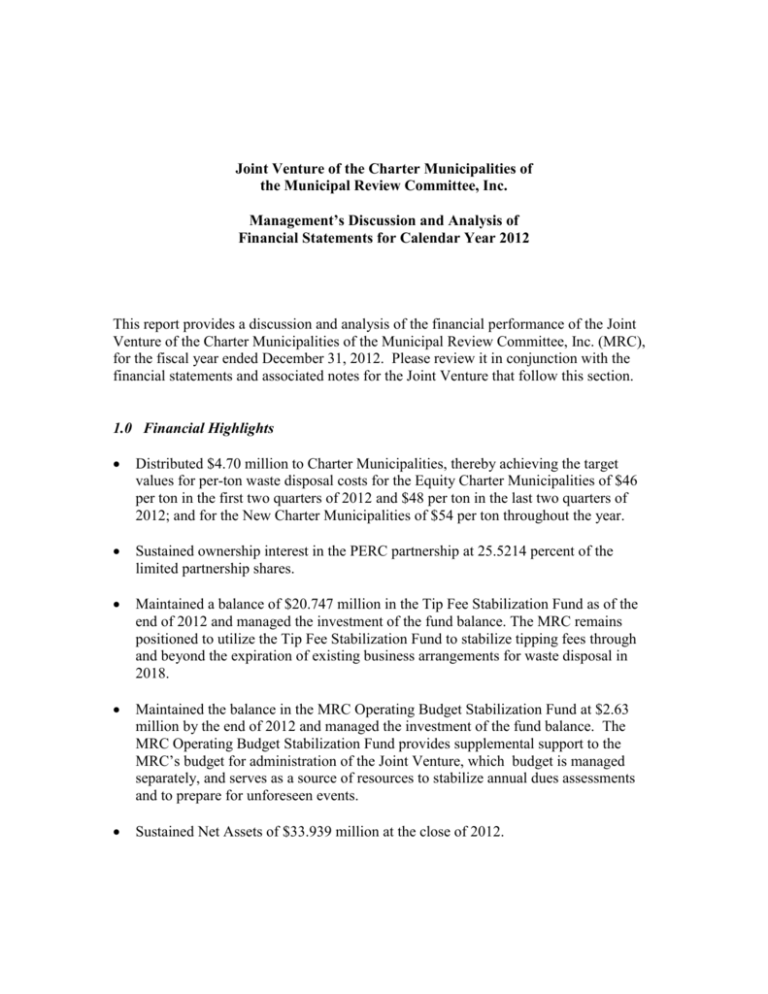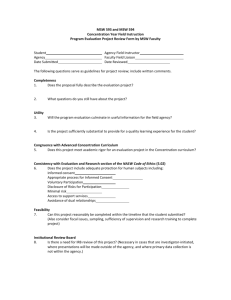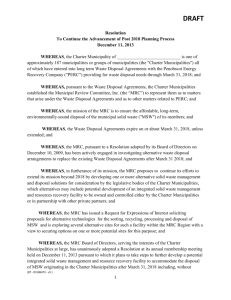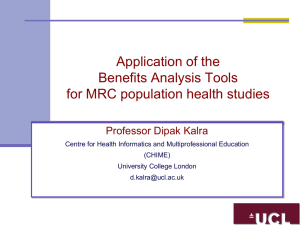Management Discussion and Analysis 2012
advertisement

Joint Venture of the Charter Municipalities of the Municipal Review Committee, Inc. Management’s Discussion and Analysis of Financial Statements for Calendar Year 2012 This report provides a discussion and analysis of the financial performance of the Joint Venture of the Charter Municipalities of the Municipal Review Committee, Inc. (MRC), for the fiscal year ended December 31, 2012. Please review it in conjunction with the financial statements and associated notes for the Joint Venture that follow this section. 1.0 Financial Highlights Distributed $4.70 million to Charter Municipalities, thereby achieving the target values for per-ton waste disposal costs for the Equity Charter Municipalities of $46 per ton in the first two quarters of 2012 and $48 per ton in the last two quarters of 2012; and for the New Charter Municipalities of $54 per ton throughout the year. Sustained ownership interest in the PERC partnership at 25.5214 percent of the limited partnership shares. Maintained a balance of $20.747 million in the Tip Fee Stabilization Fund as of the end of 2012 and managed the investment of the fund balance. The MRC remains positioned to utilize the Tip Fee Stabilization Fund to stabilize tipping fees through and beyond the expiration of existing business arrangements for waste disposal in 2018. Maintained the balance in the MRC Operating Budget Stabilization Fund at $2.63 million by the end of 2012 and managed the investment of the fund balance. The MRC Operating Budget Stabilization Fund provides supplemental support to the MRC’s budget for administration of the Joint Venture, which budget is managed separately, and serves as a source of resources to stabilize annual dues assessments and to prepare for unforeseen events. Sustained Net Assets of $33.939 million at the close of 2012. Management’s Discussion and Analysis of Financial Statements for Calendar Year 2012 Page 2 2.0 Overview of the Financial Statements The basic financial statements of the Joint Venture are presented herein in a format that is consistent with the requirements of the Government Accounting Standards Board. The financial statements present the following two different views of the Joint Venture: 1. The Government Funds Balance Sheet / Statement of Net Assets (Balance Sheet) identifies and presents values for the key general fund assets and liabilities of the Joint Venture as of the end of the calendar year (see Table 1). The Balance Sheet also identifies and presents adjustments for long-term assets and fund balances that are not readily available for application to expenditures, and identifies and presents Net Assets after application of the adjustments. The key General Fund assets shown on the Balance Sheet include the following: o Cash and cash equivalents, which are held in a Custody Account at Bangor Savings Bank. o Financial investments, consisting of the Tip Fee Stabilization Fund and the MRC Operating Budget Stabilization Fund, which are invested in a set of bonds of varying maturities and managed by an investment advisor, Peoples United Bank. o The Equity Charter Municipality investment in PERC, which is a long-term asset that is not readily available for use to meet expenditures. This investment is valued on the basis of the equity investment method as of the start of 2012. The key General Fund liability shown on the Balance Sheet for the end of 2012 is the distributions payable to the Charter Municipalities in the first quarter of 2013. The remaining assets include the value of the investment in PERC and the values of the various funds in excess of the distributions payable. 2. The Statement of Governmental Fund Revenue, Expenditures and Changes in Fund Balances / Statement of Activities (Income Statement) identifies and presents revenues and expenditures over the course of calendar year 2012 (see Table 2). The Income Statement also identifies and presents the changes in Net Assets over the course of 2012. The General Fund revenues shown on the Income Statement include the following: o Performance Credits as a result of PERC operations that were distributed to the MRC on behalf of the Charter Municipalities. o Partnership distributions as a result of PERC operations (Net Cash Flow) that Management’s Discussion and Analysis of Financial Statements for Calendar Year 2012 Page 3 were distributed to the MRC on behalf of the Equity Charter Municipalities that own limited partnership shares in the PERC partnership. o Appreciation of investments, interest income and changes in investment fund values. The General Fund expenditures shown on the Income Statement include the following: o Cash distributions to the Charter Municipalities paid quarterly. o Transfers from the operating Budget Stabilization Fund to the MRC operating fund, which is the fund used by the MRC for its administrative expenses. The MRC made one such transfer in 2012 in the amount of $70,000. o Payments by the Charter Municipalities to PERC for GAT shortfall penalties (see Section 4.0 below). Such payments were made by the MRC and recovered from the Charter Municipalities through offsets against cash distributions. The Income Statement includes adjustments to reconcile the excess of revenues over expenditures with the change in Net Assets by accounting for changes in the cash distributions payable each quarter; the release of reserve funds; and the change in the valuation of the holdings in PERC on an annual basis. 3.0 Analysis of Overall Financial Position and Results of Operations The MRC manages the assets of the Charter Municipalities in order to achieve two key objectives. First, the MRC seeks to distribute sufficient cash on a quarterly basis to the Charter Municipalities in order to reduce their net cost for disposal of waste at the PERC facility to a pre-determined system-wide average per-ton net cost known as the “target value.” In 2012, the target values for Equity Charter Municipalities were $46 per ton in the first two quarters and $48 per ton in the last two quarters, which represented the second increase in the target value since 1998. The target value for the New Charter Municipalities was $54 per ton throughout the year. Second, the MRC seeks to position the Charter Municipalities to continue to achieve target values to be determined by the MRC Board of Directors through 2018 by (a) ensuring that the Facility maintains its performance in providing waste disposal services; (b) maintaining an appropriate ownership position in the PERC partnership; (c) setting aside sufficient funds in the Tip Fee Stabilization Fund, and (d) managing other Net Assets, The MRC distributed sufficient cash in each of the four quarters of 2012 to achieve the target values as shown in the following table: Management’s Discussion and Analysis of Financial Statements for Calendar Year 2012 Quarter Tip fee, prior quarter Distribution to Equity Charter Municipalities Net disposal cost for Equity Charter Municipalities, system weighted average Target value for Equity Charter Municipalities Distribution to New Charter Municipalities Net disposal cost for New Charter Municipalities Target value for New Charter Municipalities Page 4 1 $73.20 $27.20 2 $76.50 $30.50 3 $73.00 $25.50 4 $73.00 $25.00 $46.00 $46.00 $48.00 $48.00 $46.00 $46.00 $48.00 $48.00 $19.20 $22.50 $19.00 $19.00 $54.00 $54.00 $54.00 $54.00 $54.00 $54.00 $54.00 $54.00 All values are in dollars per ton. At the end of 2012, the balance in the Tip Fee Stabilization Fund was $20.747 million. Accounting for this balance, and accounting for anticipated Performance Credits, and PERC partnership distributions (assuming that the PERC facility will continue to perform in the future as it has in the past few years), as of the end of 2012 the MRC continued to project that the Charter Municipalities would have sufficient resources to continue to achieve the projected target values through 2018. A key purpose of the Tip Fee Stabilization Fund is to position the Charter Municipalities to realize the benefits of continuance of the MRC mission of affordable, long-term, environmentally sound disposal of MSW beyond 2018. The MRC has recognized that maintaining the existing target values unchanged would deplete the balance in the Tip Fee Stabilization Fund in a way that could undermine the MRC’s capability to achieve its mission beyond 2018. Note that the MRC projects that tipping fees in any extended arrangement would be significantly higher than the current target values for a variety of reasons, most particularly the projected decline in electricity revenues after the expiration in 2018 of the existing electricity sales agreement. In this context, at its October 2010 meeting, the MRC Board of Directors voted to adopt a Target Value Step Increase Implementation Plan (the “Plan”) to implement an increase in target values on an annual basis through 2018. The Plan establishes increased target values for the Equity Charter Municipalities as follows: $46 per ton as of July 1, 2011 $48 per ton as of July 1, 2012 $51 per ton as of July 1, 2013 $55 per ton as of July 1, 2014 $59 per ton as of July 1, 2015 Management’s Discussion and Analysis of Financial Statements for Calendar Year 2012 Page 5 $63 per ton as of July 1, 2016 $67 per ton as of July 1, 2017 The target value for the New Charter Municipalities would stay at $54 per ton through July 1, 2014, then increase in accordance with the scheduled set forth above thereafter. The intent of these increases is to avoid a spike in disposal costs and prepare the Charter Municipalities for higher post-2018 disposal costs; and to maintain funds in reserve for use in enhancing the negotiating position and capacity of the MRC to make available the best possible post-2018 arrangements for management of MSW by the Charter Municipalities. 4.0 Significant Transactions The MRC managed the following transactions on a routine basis during the year: o Receipt of Performance Credits from PERC on a monthly basis. o Receipt of partnership distributions from PERC on a monthly basis. o Distribution of cash to Charter Municipalities to achieve the target values on a quarterly basis. o Transfer of funds to the Custody Account from the Tip Fee Stabilization Fund in the second quarter of 2012. o Transfer of funds to the MRC operating account from the Operating Budget Stabilization Fund in the third quarter of 2012. As of the start of 2012, $0.667 million in cash that had been released from reserve funds held by the trustee to the bond financing in 2011 remained in the Custody Account. The MRC Board negotiated with the private partners in PERC an agreement to swap such cash for an identical amount of cash being held by the private partners as part of the reserves for the loan financing. That transfer was implemented in February 2012. During 2012, the Charter Municipalities made a payment of $20,000 to PERC for a shortfall in deliveries of municipal solid waste as compared to the Guaranteed Annual Tonnage incurred during 2011. The payment was made pursuant to a negotiated settlement that also accounted for solid waste originating within the Charter Municipalities and delivered to the PERC facility, but credited to various commercial accounts. The penalty was initially paid by the MRC, then reimbursed by the Charter Municipalities having shortfalls through offsets against cash distributions. Management’s Discussion and Analysis of Financial Statements for Calendar Year 2012 Page 6 5.0 Capital Assets and Debt Administration The MRC had no outstanding debt in 2012. The MRC no longer receives payments of principal and interest on the Promissory Note from Bangor Hydro as had been the case in 2008 and previous years. Bangor Hydro made the last payment of principal and interest on the Note in May 2008. 6.0 Economic Factors and Significant Foreseeable Future Conditions The MRC notes the following significant foreseeable future conditions with the potential to affect performance in 2013: Facility maintenance costs. The facility operator, acting for PERC, LP, is planning to incur major maintenance expenditures for the Facility to ensure that operations continue through and beyond 2018. Implementation of capital and maintenance investments in the Facility’s major processing and production systems will continue to be an integral factor in maintaining economic performance in 2013 and thereafter. The total cost of the investments required to sustain economic performance has increased in recent years. There is no assurance that the level of future investment in capital and major maintenance projects at the Facility as required to maintain current levels of performance will not exceed projections in the coming years, or that performance will be maintained at current levels. As a facility with a nameplate generating capacity of more than 20 MW, the Facility is required to comply with new requirements for the reliability and security of the regional electric grid as overseen by the Northeast Power Coordinating Council (NPCC), the North American Electricity Reliability Corporation (NERC) and other related organizations of applicable jurisdiction. These requirements, which can require changes to physical plant as well as development and documentation of operating procedures, continue to evolve and expand. There is no assurance regarding the nature of the full set of NPCC and NERC requirements that the Facility might be required to implement, nor is there assurance regarding the cost and impact on performance of satisfying such requirements. Waste acquisition. In 2012, PERC received 311,631 tons of municipal solid waste (MSW). The MSW included 117,381 tons of MSW from commercial and spot market arrangements to supplement the 180,456 tons of MSW delivered by Charter Municipalities and 13,794 tons of MSW delivered by other municipalities. MSW Management’s Discussion and Analysis of Financial Statements for Calendar Year 2012 Page 7 deliveries to PERC by Charter Municipalities declined by 2,818 tons from 2011 to 2012, a drop of 1.5 percent, and, per PERC’s records, fell short by 3,796 tons of the guaranteed annual tonnage (GAT) that the Charter Municipalities, in aggregate, were obligated to deliver to PERC in 2012 to avoid shortfall penalties. Such shortfall does not account for MSW delivered to PERC that originated within the boundaries of Charter Municipalities but was credited to the accounts of commercial haulers. Whether such shortfall penalties will be assessed in 2013 for a shortfall in 2012, and the magnitude of such penalties, had not been finalized as of this writing. Quantities of MSW available to the PERC facility have declined for a number of reasons, including lingering effects of the economic downturn; waste reduction or diversion through pay-as-you-throw and similar programs; and increased recycling resulting from new single-stream programs. There is no assurance that MSW from the commercial and spot market arrangements will continue to be available to PERC in the future in the same quantities as it was acquired in the past, nor is there assurance that the quantities of MSW delivered by the Charter Municipalities, which include significant amounts of MSW originating from commercial sources within their borders and delivered to the account of the municipalities, will not decline from delivery levels in prior years. Thus, there is no assurance that the Charter Municipalities will not be exposed to further delivery shortfall penalties in future years. Moreover, there is no assurance that the Charter Municipalities will not be exposed to reduced Performance Credits and distributions of cash from the PERC Partnership due to reduced economic performance at PERC as a result of declines in waste deliveries. Competition with other disposal facilities. PERC actively competes with other disposal facilities to acquire MSW as needed to allow the facility to operate at capacity. Competing disposal facilities at the start of 2013 include two other operating municipal waste combustion facilities in Maine; operating landfills that are permitted to accept MSW in Maine; and facilities that are located outside of Maine. Failure of PERC to attract sufficient MSW to allow the facility to operate at capacity, or loss of significant quantities of MSW to competing disposal facilities, could have a significant adverse impact on the economic performance of PERC in 2013 and thereafter, and could adversely affect the capability for Charter Municipalities to achieve the target values through 2018. The competitive market for disposal of MSW in Maine changed dramatically at the end of 2012 due to the following events: Management’s Discussion and Analysis of Financial Statements for Calendar Year 2012 Page 8 1. The Maine Energy Resource Company (MERC) facility in Biddeford was shut down permanently at the end of 2012. The MERC facility had previously accepted for disposal about 120,000 tons per year of MSW generated in Maine and nearly 170,000 tons per year of MSW from other states. Such MSW must now be managed through other facilities. 2. The Juniper Ridge Landfill in Old Town is the subject of a pending application to the Maine DEP to amend its operating license to allow acceptance of unprocessed MSW for disposal from in-state sources. The license amendment is being requested by a corporate affiliate of Casella Waste Systems, Inc. (Casella), which operates the Juniper Ridge Landfill, and which owned and operated the MERC facility, through corporate affiliates. 3. In light of the above, the PERC partnership, PERC’s private owners, and Casella negotiated a new contract (the Casella-PERC Contract) regarding delivery of MSW to the PERC facility from in-state sources, including MSW that had previously been delivered to the MERC facility. The new Casella-PERC contract would have Casella deliver up to 100,000 tons per year of MSW to the PERC facility, including up to 30,000 tons per year of MSW that had previously been delivered to the MERC facility from in-state sources. Thus, the new arrangements provides additional assurance that the PERC facility will be able to secure sufficient MSW to operate at or near its full capacity with maximum reliance on MSW generated within Maine and with reduced reliance on MSW imported from other states. Nonetheless, there is no certainty that the PERC facility will not face shortfalls in the availability of MSW as required to operate at full capacity. Such circumstances might have a significant adverse impact on the economic performance of PERC in 2013. Environmental regulation. Many aspects of the operation of the Facility are subject to stringent regulation of the Maine Department of Environmental Protection (the DEP) and by other federal, state and local agencies. Thus, there is always a risk that changes in applicable, law, regulations, or regulatory policies and enforcement practices will have an adverse impact on the Facility’s performance or the economics of continuing Facility operation. The Facility works diligently to comply with all applicable environmental laws, regulations, permits and policies. In addition, the MRC works jointly with PERC on an ongoing basis to monitor potential changes in applicable laws, regulations, permits and policies in order to identify initiatives that might have an adverse impact on the Facility and to ensure that such impacts are recognized and given due consideration. Nevertheless, there is no assurance that the Management’s Discussion and Analysis of Financial Statements for Calendar Year 2012 Page 9 Facility will not be adversely affected in the future by changes in applicable law, regulation, regulatory policy or enforcement practices The products of combustion at the Facility that are emitted to the atmosphere include, among other things, carbon dioxide, which is considered a contributor to global warming and, pursuant to a 2009 ruling of the U.S. Environmental Protection Agency, is also considered a regulated pollutant. The contributions to global warming of the Facility’s emissions of carbon dioxide are more than offset by two factors of its operation. First, the Facility combusts municipal solid waste that, had it been deposited in a landfill, might have caused emissions to the atmosphere of methane and other greenhouse gases with a greater overall contribution to global warming than what was emitted from the Facility. Second, the Facility generates electricity from the combustion of waste that displaces a like amount of electricity that might have been generated from combustion of fossil fuels at facilities with emissions that contribute proportionately more to global warming than the Facility. Nonetheless, both the U.S. Congress and the U.S. Environmental Protection Agency are considering new measures to control carbon dioxide emissions and global warming that might have an adverse impact on Facility operations. There is no assurance as to what the nature or magnitude of such impacts might be. Electric utility regulation. In 2012, approximately 56 percent of all revenue realized by PERC was in the form of payments for electricity purchased by Bangor Hydro pursuant to a Power Purchase Agreement (PPA) that was originally executed in 1984 and is expected to remain in effect through March 31, 2018. Such purchases undertaken pursuant to the PPA in 2012 were at prices generally in excess of market rates for electricity and associated products. In recognition of the PPA prices for electricity and related contract terms, in 1998 the PPA was amended to provide cost mitigation to Bangor Hydro. Such amendment was reviewed and approved by the Maine Public Utilities Commission (the Maine PUC), which has regulatory jurisdiction over Bangor Hydro and its power purchase arrangements. The Maine PUC ruled that the above-market purchases of electricity by Bangor Hydro pursuant to the PPA qualify as “stranded costs” and has set forth a procedure for recovery of such costs on an ongoing basis. Nevertheless, there is no assurance that the Facility might not be adversely affected in the future by changes in the regulatory treatment of electricity purchases pursuant to the PPA or by changes in the procedures for recovery of stranded costs. Emerging technologies. The MRC is aware of numerous new technologies that are being developed to process and dispose of municipal solid waste, including approaches that utilize pelletization, gasification, pyrolysis, plasma arc destruction, Management’s Discussion and Analysis of Financial Statements for Calendar Year 2012 Page 10 anaerobic digestion, thermal de-polymerization and other methods. At this point, none of these technologies has been demonstrated in the United States on a commercial basis and scale to provide substantial economic, technical and environmental advantages for solid waste management as compared to the PERC Facility. Although a facility has been proposed for development in Augusta, Maine, there are no facilities applying such technologies to solid waste management that are operating or under construction in Maine. Nevertheless, it is possible that such a technology will be developed and emerge in the future as a disruptive technology that is competitive with the PERC Facility, with adverse economic consequences on the Facility. The MRC continues to work with the private partners in PERC to monitor and evaluate the emergence of such technologies from the perspective of (a) modifying the PERC facility to incorporate such technology; or (b) evaluating whether a facility incorporating such technology might be a competitive threat to the PERC facility.







